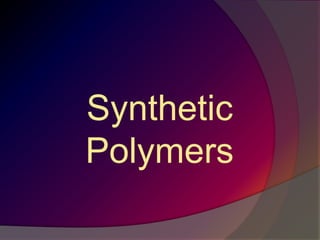
Synthetic polymers chemistry
- 2. By: Soo Ying Yu Sharanya Mohanadas Christina Ong Ng Yi Von Tan Kah Peng
- 4. Polymers are large molecules made up of many smaller and identical repeating units joined together by covalent bonds . These molecules are called monomers . Polymerization is the chemical process by which the monomers are joined together to form a big molecule known as a polymer . A polymer is a macromolecules (a very big molecules) . Hence , the relative molecular mass of a polymer is large . The properties of a polymer are different from its monomers .
- 5. POLYMERS CAN BE DIVIDED INTO 2 TYPES: a) Naturally occurring polymers Polymers that exists in living things in nature (plants and animals) b) Synthetic polymer Polymers that are man-made by chemical processes in the laboratories.
- 6. Natural polymers Synthetic polymers Exist in living things in nature (plants or animals) Examples:- (1) Protein - amino acids protein (monomer) (polymer) (2) Carbohydrates - glucose carbohydrate (monomer) (polymer) (3) Natural rubber - isoprene natural rubber (monomer) (polymer) Polymers that are man- made by chemical processes in the laboratories Many of the raw materials for synthetic polymers are obtained from petroleum, after the refining and cracking processes Example:- (1)Plastics (2) Fibres (3) Elastomer 2 types of polymerisation:- (1) Addition polymerisation (2) Condensation polymerisation
- 8. Synthetic Polymer Advantages Disadvantages Thermoplastics • Light • Low processing costs • High strength • Melt • Deformed when exposed to high levels of stress • Chemical Leaching Thermoset • retain their strength and shape even when heated • Cannot be recycled • Cannot be remolded or reshaped Elastomer • Recyclable Material • Resistance • Soft • Relatively high cost • If heated to a relatively high temperature, they tend to lose their ‘rubbery’ property Synthetic fiber • cheaper than natural fiber • Easy to wash and dry up quickly • Synthetic fibers burn more easily • Damage by hot washing
- 9. Synthetic Rubber made by mixing two by-products of petroleum refining, butadiene and styrene. mixed with soapsuds to make liquid latex then dried into bits and pressed into bales about 70 percent of all rubber is synthetic
- 11. Types of synthetic rubber
- 13. Nylon 6-6 high mechanical strength, great rigidity, and good stability under heat is required carpet fibres, tyres, zip ties, ropes, conveyor belts, hoses
- 15. ELASTOMER A polymer that can regain its original shape after being stretched or pressed. For example : Both natural rubber and synthetic rubber. Two types of polymerization processes: Addition polymerization Condensation polymerization Addition polymerization - Plastics such as polythene and PVC Condensation polymerization - Synthetic fibers such as nylon and Terylene.
- 16. PROPERTIES OF SYNTHETIC POLYMERS The physic properties of a polymer, such as its strength and flexibility depend on : Chain length – the longer the chains the stronger the polymer Side groups – polar side groups give stronger attraction between polymer chains, making the polymer stronger. Cross-linking – if polymer chains are linked together extensively by covalent bonds, the polymer is harder and more difficult to melt.
- 17. POLLUTION PROBLEM CAUSED BY SYNTHETIC POLYMERS 1. Non-biodegradable - cannot be decomposed by bacteria or other microorganisms. Disposal problems - not decay like other organic garbage. 2. Discarded plastic items may cause blockage of drainage systems and rivers. Flash floods 3. Plastic bottles and containers that are not buried in the ground will become breeding grounds for mosquitoes. Dengue
- 18. 4. Small plastic items that are thrown into the rivers, lakes and seas are sometimes swallowed by aquatic animals. Animals die from choking 5. The open burning of polymers may release harmful and poisonous gases that will cause air pollution. Burning of PVC will release hydrogen chloride gas which contributes to the acid rain problem.
- 19. METHODS TO OVERCOME ENVIRONMENTAL PROBLEMS OF POLYMERS Reused - Collected and reused or reprocessed to make new items. Reduce - Reduce the use of non- biodegradable polymers. Recycle
- 20. DEVELOP BIODEGRADABLE POLYMERS The polymers can be decomposed by bacteria, other microorganisms or simply by sunlight (photodegradable). One type of biodegradable polymer was developed by incorporating starch molecules into the plastic materials so that they can be decomposed by bacteria.
- 21. Make the world a better place.
